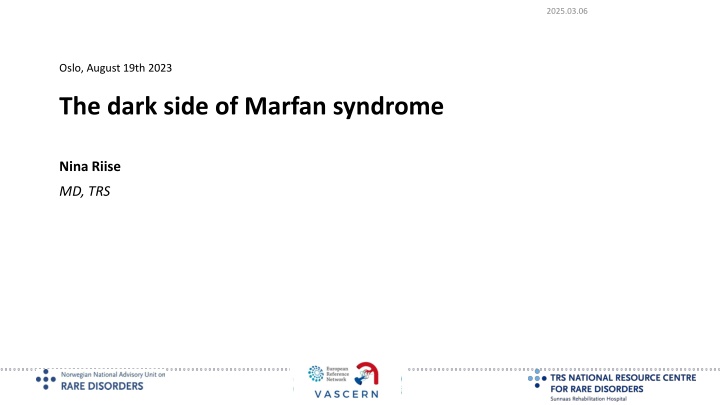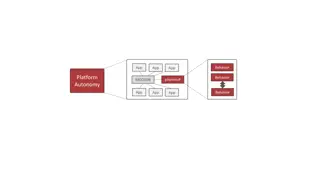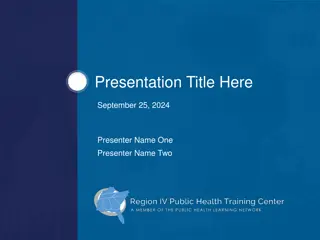Clear Mission and Commitment to Public Good
The institution's mission is publicly articulated, guiding its operations. It reflects a commitment to the public good through accessible education, stakeholder involvement, and civic engagement opportunities. Strategic planning, shared governance, and diverse program offerings contribute to fulfilling this mission.
Uploaded on Mar 06, 2025 | 0 Views
Download Presentation

Please find below an Image/Link to download the presentation.
The content on the website is provided AS IS for your information and personal use only. It may not be sold, licensed, or shared on other websites without obtaining consent from the author.If you encounter any issues during the download, it is possible that the publisher has removed the file from their server.
You are allowed to download the files provided on this website for personal or commercial use, subject to the condition that they are used lawfully. All files are the property of their respective owners.
The content on the website is provided AS IS for your information and personal use only. It may not be sold, licensed, or shared on other websites without obtaining consent from the author.
E N D
Presentation Transcript
2025.03.06 Oslo, August 19th 2023 The dark side of Marfan syndrome Nina Riise MD, TRS
TRS National Resource Centre for Rare Disorders is a part of https://helsenorge.no/sjeldnediagnoser The Advisory Unit consists of a central unit and nine national resource centres: Center for Rare Disorders Frambu Resource Centre for Rare Disorders National Centre for Rare Epilepsy-Related Disorders National Neuromuscular Centre NevSom Norwegian Centre of Expertise for Neurodevelopmental disorders and Hypersomnias Norwegian Resource Centre for Cystic Fibrosis TAKO-centre National Resource Centre for Oral Health in Rare Diagnoses The Norwegian Porphyria Centre TRS National Resource Centre for Rare Disorders
2025.03.06 3 The article Features of Marfan syndrome not listed in the Ghent nosology the dark side of the disease Yskert von Kodolitsch is the first author 19 co-authors, among them Svend Rand-Hendriksen, Thy Thy Vanem and Nina Riise from Norway Many of the co-authors are members of VASCERN
2025.03.06 4 Method The German Marfan foundation made a list of suspected Marfan features Article search: 6200 articles => 259 articles selected as a foundation for new features The authors read the articles in their respective fields Conclusions regarding the significance of clinical signs
2025.03.06 5 The aortic valve Bicuspid aortic valve is a distinct cause of aortic disease and not a feature of Marfan syndrome Bicuspid valve may coincide with Marfan syndrome and aggravate proximal aortic aneurysmal disease
2025.03.06 6 The mitral valve The valve between the left atrium and ventricle Mitral valve prolapse is an age related feature of Marfan syndrome more frequent/prevalent with increasing age Endocarditis increases after 30 years of age Mitral valve prolapse is associated with dural ectasia, lens dislocation and skeletal features Mitral valve insufficiency increases the risk of heart failure
2025.03.06 7 The pulmonary valve / artery The valve between the right ventricle and the pulmonary artery Some people with Marfan syndrome have signs of valve prolapse and a dilatation of the pulmonary artery These findings usually have no clinical relevance for the affected person
2025.03.06 8 The tricuspid valve The valve between the right atrium and ventricle Prolapse of the tricuspid valve is most prevalent in people in their 30 s (32%) Prolapse of the valve is related to thickening The mitral valve and the tricuspid valve are frequently affected simultaneously Progression of the severity from mild to moderate or severe regurgitation occurs only in a small fraction of affected individuals Affection of the tricuspid valve is much more common than previously assumed
2025.03.06 9 Conclusion regarding valves The valves on the left side of the heart (the mitral and aortic valves) are more severely affected than on the right side (the tricuspid and pulmonary valves) The changes are age related The changes on the right side of the heart are more prevalent than we have assumed and should be followed up
2025.03.06 10 The heart muscle Affection of the heart muscle (cardiomyopati) is a feature of Marfan syndrome Both the right and left side of the heart are affected This may lead to heart failure and arrythmias, particularly in combination with valve insufficiency Most have mild heart failure
2025.03.06 11 Arrythmias Increased prevalence of atrial fibrillation Arrythmias in the ventricles (ventricular arrythmias) may become life threatening Increased prevalence of EKG changes A low threshold for examination and treatment of arrythmias is recommended
2025.03.06 12 Arterial affection Arterial tortuousity is common Strong arterial tortuousity signifies more aggressive arterial affection Aneurysms in (medium) sized arteries are more prevalent than in the general population Other arteries are more frequently affected in people who have had aortic surgery or dissection Dissections in the neck and head that can cause strokes are not common in Marfan syndrome The prevalence of atherosclerosis seems to be normal
2025.03.06 13 Lung capacity Scoliosis, chest deformities and weaker respiratory muscles may lead to reduced lung capacity Surgeries are sometimes performed in order to stabilize pulmonary function Up to half of people with Marfan syndrome go through surgery different cultures for surgery in different countries? There are no long term studies to confirm the effect of these surgeries
2025.03.06 14 Lung tissue Spontaneous pneumothorax is a feature of Marfan syndrome, but the prevalence is unknown Bullae and cysts in the lung tissue is probably more prevalent than pneumothorax Mouse studies suggest that Losartan affects lung tissue Bronchial stenosis or dilatation may be features of Marfan syndrome It can be difficult to decide whether low fitness level, chest pain and shortness of breath are caused by reduced lung or heart function Pulmonary follow up should be a part of follow up of Marfan syndrome
2025.03.06 15 Sleep apnea Sleep apnea seems to be more prevalent in Marfan syndrome Differences in facial features and collapse of airways may cause obstructive sleep apnea Central sleep apnea has also been described The effect on the aorta is uncertain Sleep apnea may lead to fatigue and reduced quality of life Treatment: weight reduction for overweight individuals and CPAP
2025.03.06 16 Abdominal organs Increased prevalence of benign liver and kidney cysts There may be an increased prevalence of bile stones and dilated bile ducts Hiatus hernias have been reported, particularly in neonatal Marfan syndrome There is possibly an increased prevalence of diverticular disease Tendency towards increased belly fat with increasing age - risk of diabetes type 2
2025.03.06 17 The urinary tract and childbirth Kidney cysts seem to be connected with aortic disease The prevalence of other kidney diseases in people with Marfan syndrome is unknown Increased prevalence of urinary incontinence has been described One study has described increased risk of premature labour
2025.03.06 18 Musculoskeletal features Muscular changes and reduced muscle mass over time has been described, but the evidence is limited The muscular changes may cause fatigue, pain, weakness, cramps, reduced bone density and reduced pulmonary function Reduced bone density has been described in Marfans syndrome, but it is uncertain whether this causes an increased fracture risk
2025.03.06 19 Craniofacial features Shortening of the upper and lower jaw (maxilla and mandibula), elongation of the lower part of the face, enlarged sinuses and high nasal airway restriction are features of Marfan syndrome These features may cause sleep apnea and dental crowding and overjet The facial features that are described in the Ghent criteria have limited sensitivity, but fairly good specificity
2025.03.06 20 Skin findings Striae in unusual places (e g shoulders, chest, hips) are frequent in Marfan syndrome Increased prevalence of abnormale scars (hypertrophic, atrofic hypopigmented or hyperpigmented) Possibly increased prevalence of hernias
2025.03.06 21 Oral cavity More enamel defects, but not more cavities Normal prevalence of periodontitis High narrow palate, retrognathy and dental crowding is common Increased prevalence of craniomandibular dysfunction More frequent dental follow up is recommended because good oral hygiene is more difficult Good oral hygiene is important in order to prevent endocarditis
2025.03.06 22 Headache Increased prevalence of headaches due to: Migraines (recommended treatment: beta blocker or losartan) Low intracranial pressure because of spinal fluid leakage Dissection of neck arteries
2025.03.06 23 Leakage of spinal fluid Headache that usually increases in the upright positition Unspecific additional symptomes: nausea, dizziness, neck stiffness, hearing problems, blurred vision Can be triggered by minor trauma or increased intraabdominal pressure
2025.03.06 24 Diagnostic criteria for spontaneous low intracranial pressure A. Radiographic imaging shows extrathecal cerebrospinal fluid B. Cranial MRI imaging findings of spontaneous intracranial hypotension with at least one of the following: Low opening CSF pressure Spinal meningeal diverticulum Improvement after epidural bloodpatch
2025.03.06 25 Treatment of spinal fluid leakage Fluids Bed rest Caffeine Epidural blood patch can be repeated
2025.03.06 26 Psychological issues and pain There is no certain documentation of increased prevalence of developmental disturbances or psychiatric conditions in people with Marfan syndrome People with Marfan syndrome have more fatigue than the general population Chronic pain is usual in Marfan syndrome, particularly in the back, neck, shoulders, chest, knees and head There is low satisfaction with pain treatment
2025.03.06 27 Bleeding disorders Increased bleeding as well as increased tendency to thrombosis has been reported in people with Marfan syndrome Increased aortic diameter increases the risk of bleeding disturbances There are changes in fibrinolysis, thrombin and platelet function Increased shear stress may cause von Willebrand disease type 2a
2025.03.06 28 Eyes People with Marfan syndrome have corneal changes not previously described Possibly increased prevalence of cataract. Same treatment as for ectopia lentis
2025.03.06 29 Probably not features of Marfan syndrome Bicuspid aortic valve Aneurysms of the cerebral arteries Cognitive dysfunction Schizophrenia
2025.03.06 30 Probably features of Marfan syndrome Tricuspid valve prolapse Cardiomyopathy Sleep apnea Vascular disease of the aortic branch vessels Liver and kidney cysts
2025.03.06 31 Potential complications Heart failure Supraventricular and ventricular arrhythmia Restrictive lung disease Spontaneous cerebrospinal fluid leakage Fatigue Chronic pain
2025.03.06 32 Understanding of Marfan syndrome Old understanding - Young, thin patients - Isolated organ system involvement - Isolated aortic disease New understanding - Older, overweight patients - Generalized, degenerative disease - Generalized arterial disease
2025.03.06 33 Recommendations for medical guidelines and clinical care Cardiac follow up with echocardiography, blood tests and EKG Pulmonary evaluation Polysomnography Baseline imaging of abdominal organs for organ cysts
2025.03.06 34 Recommendations for medical guidelines and clinical care Evaluation for urinary incontinence in adult women Evaluation of muscle strength and bone mineral density Dental and orthodontic evaluation and follow up Pain evaluation and follow up
2025.03.06 35 Recommendations for future large studies Myocardial dysfunction and arrhythmia Sleep-disordered breathing Vascular manifestations
2025.03.06 36 Contact information Nina Riise 66969505 (secretary TRS) Nina.riise@sunnaas.no Not sensitive information























